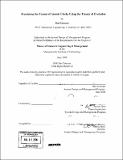| dc.contributor.advisor | Patrick Hale. | en_US |
| dc.contributor.author | Entezam, Ben | en_US |
| dc.contributor.other | System Design and Management Program. | en_US |
| dc.date.accessioned | 2009-03-16T19:30:09Z | |
| dc.date.available | 2009-03-16T19:30:09Z | |
| dc.date.copyright | 2008 | en_US |
| dc.date.issued | 2008 | en_US |
| dc.identifier.uri | http://hdl.handle.net/1721.1/44692 | |
| dc.description | Thesis (S.M.)--Massachusetts Institute of Technology, System Design and Management Program, 2008. | en_US |
| dc.description | Includes bibliographical references (leaves 59-60). | en_US |
| dc.description.abstract | The trend of technology evolution plays a very important role to understand how and why products evolve over time and define strategies of further improvements of products. The trend of evolution is based on the fact that all the products, process or technical systems will evolve over time. A cesium atomic clock is the most accurate realization of a reference unit that mankind has yet achieved. The commercial cesium atomic clock is very mature and the demand for this type of clocks expected to be flat. A size reduction is possible due to new physics improvement by using optical pumping technique, but no major changes in performance and prices are expected. The masers outperform the high performance cesium clocks for a time period of sub seconds to one day. The hydrogen maser is very mature product like cesium and the design has remained the same for the last 30 years. The product is expected to remain as presently available. Rubidium atomic clocks provide enhanced accuracy, stability and timing precision compared to quartz-based technologies. This market is large enough to support continuing technological innovation. The world's first commercially available miniature developed by Symmetricom in 2008 marks a major step toward in the evolution of rubidium atomic clocks. It is predicted that future of rubidium oscillators will be based on coherent population trapping technology. The miniature rubidium clocks will be smaller, cheaper, and will be operated by small batteries. | en_US |
| dc.description.statementofresponsibility | by Ben Entezam. | en_US |
| dc.format.extent | 60 leaves | en_US |
| dc.language.iso | eng | en_US |
| dc.publisher | Massachusetts Institute of Technology | en_US |
| dc.rights | M.I.T. theses are protected by
copyright. They may be viewed from this source for any purpose, but
reproduction or distribution in any format is prohibited without written
permission. See provided URL for inquiries about permission. | en_US |
| dc.rights.uri | http://dspace.mit.edu/handle/1721.1/7582 | en_US |
| dc.subject | System Design and Management Program. | en_US |
| dc.title | Predicting the future of atomic clocks using the Theory of Evolution | en_US |
| dc.type | Thesis | en_US |
| dc.description.degree | S.M. | en_US |
| dc.contributor.department | System Design and Management Program. | en_US |
| dc.identifier.oclc | 297178064 | en_US |
